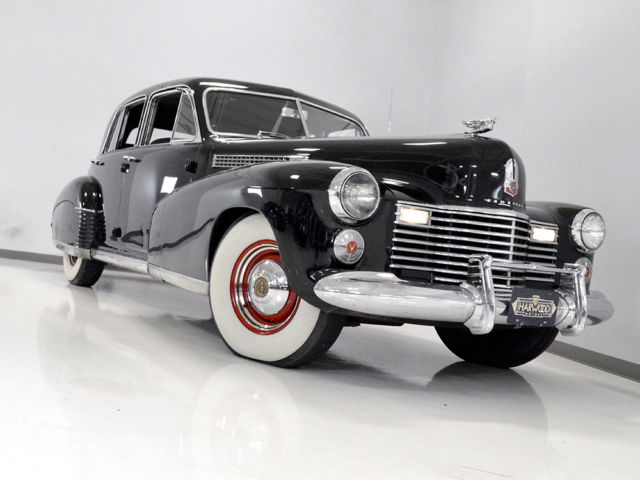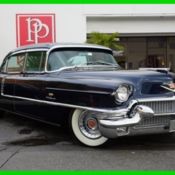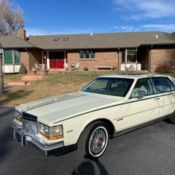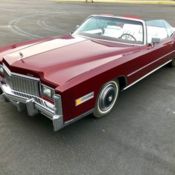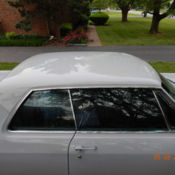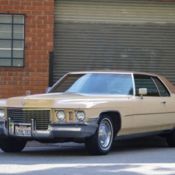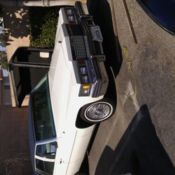Hydra-Matic, new paint, new interior, extensively serviced, ready to enjoy.
1941 Cadillac Other
Despite all the horrible things going on around the world, 1941 was a very good year for the US automobile industry. Perhaps because automakers knew these might be the last cars anyone would be buying for a while, or perhaps just because styling and technology came together in a perfect way, there were simply no unattractive cars built in 1941. Cadillac in particular had a lot to be proud of, starting with all-new styling that vaulted them straight to the cutting edge, and adding the remarkable Hydra-Matic fully automatic transmission to the options list. As a result, 1941 Cadillacs were fast, comfortable, and effortless to drive, which probably explains why they remain the single most popular car to own in the Classic Car Club of America (CCCA). If you want a pre-war car that can do everything and do it well, a 1941 Cadillac should not be overlooked.
There are also many who would argue that this 1941 Cadillac 60 Special is the most attractive 4-door sedan of all time. It was certainly a game-changer, an all-new design in 1938 that eliminated running boards offered slender window frames, which Cadillac called "Wide Vision" windows. The '41s are the definitive example of Bill Mitchell's vision, finally incorporating the dramatic front fenders that sweep into the doors and fender skirts to make it look especially long and low. There's simply no angle from which this car doesn't look gorgeous.
This 1941 Cadillac 60 Special has a known ownership history dating back to the 1970s. It was repainted in the early 1990s, but never used, as the owner passed away and his family was not interested in the car. So it sat wearing its fresh gloss black paint in heated, protected storage for nearly 20 years. As a result, the shiny finish is in excellent condition with a brilliant gloss and very few signs of use. It has never been a rusty car and perhaps most importantly on a 60 Special, the solid wood rocker reinforcements are in superb condition. All four doors open and close with that wonderful kerCHUNK sound that's endemic to these cars and makes it feel as if it will last forever. At the same time, much of the rubber weather-stripping was replaced, so the car has a very solid feel that's devoid of squeaks and rattles inside, something that is also likely due to the fact that the body has never been off the frame. The chrome and stainless trim is probably original throughout, so there's the usual very light pitting on the cast parts, but certainly nothing that needs immediate attention and in its current condition, the car attracts a great deal of attention. We should also note that the famous "egg crate" grille is not currently wearing its vertical pieces—a previous owner didn't like the busy look of the original grille, but all the parts are included with the car and they're easy to install since they're just a friction fit that can be pushed into place by hand. I personally like how it looks without them, simple and clean, so that's how we left it.
When we recovered the car from the body shop, the original interior was intact, but the front seat was threadbare and every cloth surface was infused with 20 years of body shop dust. We tried to find a match to the original fabric, but were not successful in getting a proper sample, so we decided to reupholster both the front and rear seats using a different catalog combination. A glance at the back seat of our 1941 Buick Limited limousine revealed the perfect combination of blue seats and gray trim, a combination we've replicated in this 60 Special. It was an available combination in the 60S, so no demerit there, and the look is simply gorgeous. It's actually nicer than it appears in photos, which are a bit dark, and with new stuffing underneath, it remains all-day comfortable. We also serviced the electrical system and got all the gauges working properly, including the speedometer and fuel level gauge, so it's ideal for touring. Both heater motors turn, the defroster works, and all the various courtesy lights and turn signals are functional. Only the clock and radio are not working, which is common in cars of this vintage and we have not pursued any repairs there. The trunk has also been reupholstered using correct checked fabric and there's a full-sized spare of indeterminate age stashed back there, too.
But the real reason you want to own a 1941 Cadillac is simply because they're flat-out the best-driving cars of the era, particularly when equipped with the Hydra-Matic transmission. The 346 cubic inch flathead V8 may have modest specifications on paper, but they're incredibly reliable, make magnificent torque to move these big cars, and purr along in near silence at modern highway speeds. In fact, the reason we bought this car is because, after 20 years in storage, it started almost instantly with some gas down the carburetor throat and a fresh battery. Better yet, it idled in near silence! If you're familiar with these engines, you know that a little valvetrain noise is considered normal, but this one has none! Of course, we spent several thousand dollars servicing the mechanicals, including cleaning the fuel tank, rebuilding the carburetor and fuel pump, rebuilding the distributor, new ignition components, flushing and cleaning the cooling system, and a full rebuild of the brake system, including master cylinder, hoses, wheel cylinders, and shoes. The car has repeatedly proven itself over the past 18 months we've owned it, with numerous long-distance tours and serving as my personal daily driver on sunny days. It always starts quickly, idles smoothly, and cuts through traffic with authority, all without getting hot or cranky even on the warmest days. This is not a rolling road block of an old car, but a powerful luxury car that can keep up in modern traffic with ease.
A big part of that performance advantage comes from the 4-speed Hydra-Matic automatic transmission. Don't let anyone tell you that these are trouble-prone or difficult to service, because both are false. GM knew that this transmission had to be right or else that would be the end of automatic transmissions forever, and they'd invested quite heavily in the technology. As a result, it's virtually indestructible and uses just three seals, one for the input shaft, one for the output shaft, and one on the pan. Some are leakers, some aren't, but that doesn't affect how they work, and they work superbly. This one idles in gear at about 350 RPM in almost total silence and steps off the line with authority, using the engine's considerable torque plus a very low first gear to launch all 4000 pounds of Cadillac with ease. It shifts to second pretty quickly, then it's in third for only a second or two, then to fourth where it will happily cruise at anywhere from 15 to 70 MPH. Prod it and it drops down a gear for superior passing ability, making it feel surprisingly agile in traffic. Hydra-Matic Cadillacs also received 3.36 rear gears (manual transmission cars received 3.90s) which is another component in its outstanding highway manners—at 65 MPH, it's just loafing along at about 2000 RPM, barely audible. If you want a 1941 Cadillac, a Hydra-Matic car is all you should be looking for.
The chassis on this car is original, so it's not perfect, clean, and shiny. If you want perfection you'll have to spend more, but I can almost guarantee it will not ride or drive any better than this car. Bumps are a distant and well-damped thump, steering is accurate and it tracks straight, and the freshly rebuilt brakes are as good as you're going to get for 1941. There's a correct older exhaust system that sounds just right, a bit of a V8 burble but nothing obnoxious, and I have to admit that the light tick-tick-tick of the Hydra-Matic Cadillac at idle is one of my very favorite car sounds. There's some surface scale on the heavy iron parts, so be ready for that, but the floors are in excellent condition, as are the aforementioned wooden door sills. The only notable areas are the usual ones: there's some minor perforation in the spare tire well and in the battery box, neither of which is serious enough to warrant repairs but you should be aware of it. It currently sits on 15-inch steel wheels with attractive hubcaps and trim rings, as well as a set of ancient Denman wide whitewall tires, but an upgrade to a set of wide whitewall radials would make this a car you never want to stop driving.
We intended to keep it in our own collection, that's how good it is. Circumstances have changed and we have another 1941 General Motors sedan that we've decided to keep instead, so it is only with great reluctance that this car is for sale. It runs and drives better than almost anything else we've owned and it's simply gorgeous to look at. If you want a completely sorted Full Classic Cadillac that's welcome at any event, one that you can drive without reservation and that you can show with pride, few offer a better combination of beauty and practicality than this.
- Make: Cadillac
- Model: Other
- Type: Coupe
- Year: 1941
- Mileage: 85,280
- VIN: 6343703
- Color: Black
- Number of cylinders: 8
- Fuel: Gasoline
- Transmission: Automatic
- Interior color: Blue
- Vehicle Title: Clear Want to buy? Contact seller!
